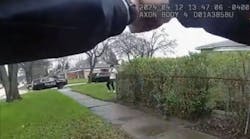Frank Borelli
Editor-in-Chief
Officer.com
Back a few years (more than I want to admit) I enlisted in Uncle Sam's Army and became a Military Policeman. I can clearly remember the physical training (PT) we underwent each morning and the PT tests we took every couple of weeks to measure our progress and (hopefully) improvement. One of the discussions I remember having with my fellow soldiers-in-training focused around the applicability of the PT and testing with regard to actual actions performed in combat. We couldn't find a correlation; apparently, decades later, neither has the Army. So, it's been announced that the Army has developed a new PT regimen that is more applicable to combat performance.
In this article on CNN 04/11/2011, we get the information about the new fitness test. Where the old test consisted of:
- two minutes of push-ups (you did the max you could in two minutes)
- two minutes of sit-ups (same deal)
- two mile run
The new test consists of:
- A 60-yard shuttle run (it's like wind sprints but carrying objects)
- Standing long jump
- One minute of 'rowers' (we'll describe them in a moment)
- One minute of push-ups
- a 1.5 mile run
Now, looking at the new activities...
The 60-yard shuttle run is a set of what we used to call 'suicides'. From the starting line you run 5 yards out, pick up an object and run it back, placing it on the starting line. Then you run 10-yards out, pick up an object and run it back, again placing it on the starting line. Then you run 15-yards out, pick up an object and run it back. The out-and-back distances all add up to 60 yards (5+5+10+10+15+15=60).
The Standing Long Jump is the same thing you used to do in school. Stand with your feet side by side at the starting line, swing your arms, squat comfortably and jump forward as far as you can with your feet landing together.
'Rowers' are like sit-ups... but not. You start out on your back with your knees bent and your feet and knees together. Your arms are stretched out above your head. You sit up as you move your hands and arms forward (I gather in an around motion rather than an over motion, until your elbows are next to your knees, and then you reverse position back to on your back.
Push-ups are still push-ups and upper body strength DOES matter in any combat situation. Whether you're pushing someone away or pushing yourself off of an object you've impacted for whatever reason, that pushing strength can be very important.
The 1.5 mile run: reduced from 2 miles because, after tons of interviews of soldiers returning from combat tours in Iraq and Afghanistan, there are very few incidences of soldiers having run over one mile in combat. The distance of 1.5 miles was chosen as optimal for testing the soldiers cardio-vascular system.
I have to say I like the new system. There are two running events but they are radically different. One involves short term move-an-object-fast type of running while the other involves a more balanced constant demand on your body for distance.
The standing long jump is a measure of your leg strength and given the load weight soldiers (and police officers) so often have to carry, leg strength is a big consideration in combat fitness. Rowers effectively replaced sit-ups and while the momentum of your arms moving can definitely make the sitting up part easier, no one can hold your feet in place making the exercise more difficult than sit-ups on your middle body.
Push-ups are push-ups but in combat situations the need for upper body strength is more explosive and immediate. Measuring it over two-minutes really never made much sense to me (or others I talked to). Why not three minutes? one minute thirty seconds? Where did 'two minutes' come from? So to see it still tested but for only one minute, and using adjusted scales of performance, just makes sense to me.
Finally, the 1.5 mile run, I think, will end up being far preferred. Those who are strong runners and were delivering good times in the 2 mile run should do even better in the 1.5 mile run. They can burn the energy they have a little faster and harder and cut down their mile time somewhat. Those who have a harder time with the run know that they only have to run 75% of what they used to and it's an easier mental challenge to overcome to push through it at a better pace.
I think the greatest strength overall, though, is the variety of motion and activity this new test encompasses. While I still feel an obstacle-course type of PT test might be a better option, I think the Army is moving in the right direction. What do you think?


